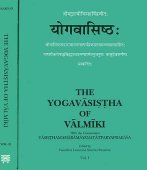Mayavada, Māyāvāda, Maya-vada: 8 definitions
Introduction:
Mayavada means something in Hinduism, Sanskrit. If you want to know the exact meaning, history, etymology or English translation of this term then check out the descriptions on this page. Add your comment or reference to a book if you want to contribute to this summary article.
In Hinduism
Vaishnavism (Vaishava dharma)
Source: Pure Bhakti: Bhagavad-gita (4th edition)Māyāvāda (मायावाद) refers to “doctrine of illusion. This theory, advocated by the impersonalist followers of Śaṅkarācārya, holds that Bhagavān’s form, this material world and the individual existence of the living entities are māyā, or false. This philosophy accepts the authority of Vedic texts but interprets them in such a way as to advance an impersonal conception of the Absolute and deny the personal feature of Godhead. It is known as covered Buddhism, since Buddhism is overtly atheistic”. (cf. Glossary page from Śrīmad-Bhagavad-Gītā).
Source: Pure Bhakti: Brhad BhagavatamrtamMāyāvāda (मायावाद) refers to:—Proponents of a philosophy that posits that qualities such as personhood, form and name are an illusion, or Māyā, imposed on the Absolute Truth, who is in reality changeless and formless, or impersonal. The foremost advocate of this philosophy, also known as Adaitavāda, was Śrīpād Śaṅkarācharya, an incarnation of Śrī Śiva. (cf. Glossary page from Śrī Bṛhad-bhāgavatāmṛta).

Vaishnava (वैष्णव, vaiṣṇava) or vaishnavism (vaiṣṇavism) represents a tradition of Hinduism worshipping Vishnu as the supreme Lord. Similar to the Shaktism and Shaivism traditions, Vaishnavism also developed as an individual movement, famous for its exposition of the dashavatara (‘ten avatars of Vishnu’).
Languages of India and abroad
Sanskrit dictionary
Source: DDSA: The practical Sanskrit-English dictionaryMāyāvāda (मायावाद).—the doctrine or illusion, (a term applied to Buddhism).
Derivable forms: māyāvādaḥ (मायावादः).
Māyāvāda is a Sanskrit compound consisting of the terms māyā and vāda (वाद).
Source: Cologne Digital Sanskrit Dictionaries: Cappeller Sanskrit-English DictionaryMāyāvāda (मायावाद).—[masculine] the doctrine of illusion (ph.).
Source: Cologne Digital Sanskrit Dictionaries: Monier-Williams Sanskrit-English DictionaryMāyāvāda (मायावाद):—[=māyā-vāda] [from māyā > māya] m. the doctrine affirming the world to be illusion (applied to the doctrine of the Vedānta and of Buddhism), [Catalogue(s)]
[Sanskrit to German]
Sanskrit, also spelled संस्कृतम् (saṃskṛtam), is an ancient language of India commonly seen as the grandmother of the Indo-European language family (even English!). Closely allied with Prakrit and Pali, Sanskrit is more exhaustive in both grammar and terms and has the most extensive collection of literature in the world, greatly surpassing its sister-languages Greek and Latin.
Kannada-English dictionary
Source: Alar: Kannada-English corpusMāyāvāda (ಮಾಯಾವಾದ):—[noun] (phil.) the doctrine that the universe is an illusion or an apparent phenomenon and the Supreme Soul is the only truth.
Kannada is a Dravidian language (as opposed to the Indo-European language family) mainly spoken in the southwestern region of India.
See also (Relevant definitions)
Partial matches: Vada, Vata, Maya.
Starts with: Mayavadakhandana, Mayavadakhandanatika, Mayavadakhandanatippani, Mayavadakhandavivarana, Mayavadaparashu, Mayavadasamdushani, Mayavadashatadushani.
Full-text: Shankaracarya, Mayavadakhandana, Mayavadakhandanatippani, Mayavadakhandavivarana, Mayavadasamdushani, Mayavadakhandanatika, Mayavadi, Dashaprakarana, Ekadanda, Ashtavakra, Shivaprakasha, Maya, Shatadushani.
Relevant text
Search found 27 books and stories containing Mayavada, Māyāvāda, Maya-vada, Māyā-vāda, Mayāvāda; (plurals include: Mayavadas, Māyāvādas, vadas, vādas, Mayāvādas). You can also click to the full overview containing English textual excerpts. Below are direct links for the most relevant articles:
Sahitya-kaumudi by Baladeva Vidyabhushana (by Gaurapada Dāsa)
Text 11.46 < [Chapter 11 - Additional Ornaments]
Shakti and Shakta (by John Woodroffe)
Chapter XXXI - Conclusions < [Section 4 - Yoga and Conclusions]
Chapter XVIII - Śākta and Advaitavāda < [Section 2 - Doctrine]
Chapter XIX - Creation as explained in the non-Dualist Tantras < [Section 2 - Doctrine]
Chaitanya Bhagavata (by Bhumipati Dāsa)
Verse 3.2.355 < [Chapter 2 - Description of the Lord’s Travel Through Bhuvaneśvara and Other Placesto Jagannātha Purī]
Verse 2.10.166 < [Chapter 10 - Conclusion of the Lord’s Mahā-prakāśa Pastimes]
Verse 3.3.34-037 < [Chapter 3 - Mahāprabhu’s Deliverance of Sarvabhauma, Exhibition of His Six-armed Form, and Journey to Bengal]
Sivaprakasam (Study in Bondage and Liberation) (by N. Veerappan)
Interpretations of the Mahavakyas by Shri Shankara < [Chapter 5 - Concept of Advatia]
Author (Umapati Shivam) and his Works < [Chapter 1 - Introduction]
Liberation in different faiths < [Chapter 7 - Liberation]
Mahayana Buddhism and Early Advaita Vedanta (Study) (by Asokan N.)
Chapter 3 - Advaita In The Mandukya-Karika
Chapter 5.1 - Comparative study of Non-Self
Mandukya Upanishad (Madhva commentary) (by Srisa Chandra Vasu)
Karika verse 1.14 < [Chapter 1 - First Khanda]
Related products
